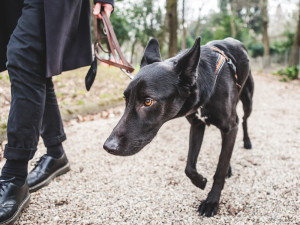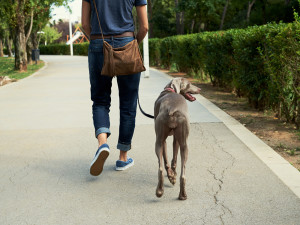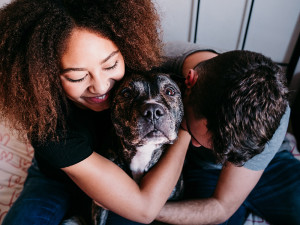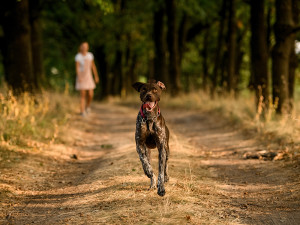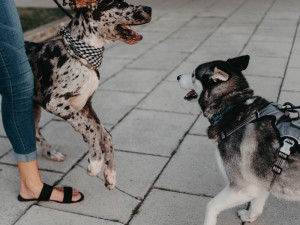Dog-on-Dog Attacks: How To Help Your Dog Recover Their Confidence
The emotional road to recovery can be a long one. Here’s what you can do
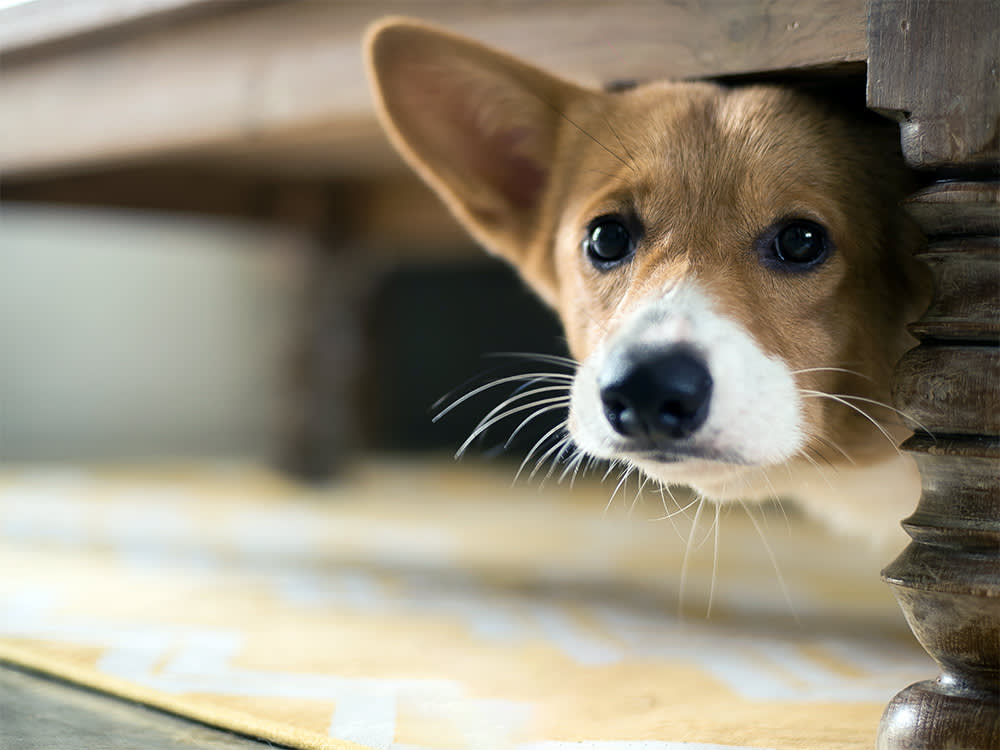
share article
As a pet parent, keeping your pup safe is your top priority. But despite the best parenting in the world, scary things can still sometimes happen, like an attack on your dog from another dog. The road to recovery can be long, emotional and paved with feelings of guilt. Here, we look at how you can help your dog recover emotionally and mentallyopens in a new tab after being attacked.
Are dog-on-dog attacks becoming more common?
There have been a lot of news stories over the past few years about dog attacks, and, in 2023, the government came to a controversial decision to ban XL Bulliesopens in a new tab. Although the numbers of dog-on-dog attacks aren’t recorded nationally, one survey does report that one in sevenopens in a new tab UK dog parents have experienced their pup being attacked by another.
It can be extremely upsetting to witness aggression or reactivity from another dog, even more so when your own pup is the target. Despite your best efforts to keep them safe, a situation like this may be beyond your control. But knowing how to help your dog regain their confidence if the worst does happen is something you can help with.
What should I do in a dog attack?
The first priority is obviously to remove your dog from any violent situation. The People’s Dispensary for Sick Animals (PDSA) has some great adviceopens in a new tab on de-escalating and removing your dog from a fight, but ideally, you’ll have them out of there before any aggression erupts. Calmly take your dog away from any situation where another dog is exhibiting behaviour that concerns youopens in a new tab. A dog who is displaying signs of so-called ‘aggressive’ behaviour is often scared or feeling threatened, and space is the best thing for them. If possible, create a barrier between them and you and your dog – something like a car door, a bike or a tree. Engage the dog’s parent, asking them to put their dog on a lead. Try not to panic – loud noises or quick movements may cause further arousal in the dog.
If things have already escalated, try to remain calm, call your dog away and encourage the other pet parent to do the same to theirs. Distraction tactics are good; loud claps or noises may help shift their attention (note: no loud noises if the other dog is acting aggressive, but loud noises if the dog has already attacked). If the other dog refuses to let go of yours, the PDSA recommend against trying to pull the dogs apart. “If anything, push against the force of the bite, which is more likely to make the dog let go.”
Make sure to collect the details of the other dog and their parent, and take pictures of any injuries your dog has suffered. If there are injuries, get your pup to the vet ASAP.
How can I comfort my dog after an attack?
The first few hours and days can be crucial to healing both physically and mentally. The most important first step is to take your dog to the vet and have any severe woundsopens in a new tab and ailments assessed by a trained medical team. You should ask the vet how to administer any medication your dog will need at home and seek professional advice on any injuries for the days to come.
In the hours and days following, it’s important to be aware of your dog’s emotional needs and requirements. Tuning in to this information will help ensure that your dog feels safe and supported during this stressful time. Poole-based dog behaviourist and reactivity specialist Nic Cramptonopens in a new tab says that even if your dog is not physically wounded there will be an emotional impact.
“Your dog’s adrenaline and cortisol will have spiked during the altercation, and once home in your dog’s safe environment, you should try to ensure that they are kept warm, calm and quiet, away from any other dogs in the household and offer fresh drinking water,” she says. “Something to lick or chew will also really help your dog to self-soothe.” By self-soothing, your dog’s cortisol levels will decrease, allowing them to decompress and get out of fight or flight mode.
Keeping your dog mentally stimulated and lightly exercised with indoor toys and enrichment activities may be helpful in this instance. Think: rope toys for tug-of-war gamesopens in a new tab and scent-based treat puzzlesopens in a new tab as a calming distraction to keep their mind active.
Depending on the intensity of the incident, and your dog’s own resilience, Nic says that your pup may need anything from a couple of days to even a week before they feel happy to venture out again.
What are the signs that your dog is scared?
One of the first key steps to helping your dog through this turbulent time is understanding what a fear-based reactive responseopens in a new tab actually looks like from your dog. This will help to keep both you and your dog safe, by allowing you to intervene before they escalate.
Nic explains signs to watch for:
Tremblingopens in a new tab or trying to run away.
Lunging, snarling and barkingopens in a new tab.
Freezingopens in a new tab, licking their lips, tucking their tail and laying their ears flatopens in a new tab.
“Another great indicator of your dog being scared is what they are like with the treats that you are offering,” says Nic. “If they are not interested at all, or coughing them back up, or are just very ‘snatchy’ when taking treats, this means that your dog is ‘over threshold‘, ie, simply too stressed and you need to get them out of that mindset, pronto.”
How can I help my dog regain confidence?
If your dog gets attacked, it can have a huge impact on them – not just physically, but mentally, too. A dog’s confidence can be knocked in much the same way that a human’s can and, just like a human, a dog is unlikely to want to rush back into a similar environment straight after such a traumatic experience.
Cambridgeshire-based dog walker and rescue dog trainer Sadie Geoghegan-Dannopens in a new tab confirms that dropping a dog in at the deep end following such a traumatic ordeal is never a good idea as it could trigger their fight or flight response, resulting in anxious, reactive behavioursopens in a new tab that turn walks into an unpleasant experience for both of you. Instead, choose quieter walking times and less populated routes.
Sadie says that dogs who’ve been through a traumatic event would also benefit from desensitisationopens in a new tab and counter-conditioning training. “Desensitisation is where a dog is slowly reintroduced to a trigger (in this case, other dogs) from a safe distance that doesn’t cause their emotional response to tip over threshold,” she says. “You’ll work together to gradually decrease the distance between your dog and other dogs, working out where their sweet spot is; the distance that they’re most comfortable.”
You’ll recognise the sweet spot as where your dog is able to comfortably disengage from a trigger without going over the threshold. This means they can observe another dog, but happily check back in with you afterwards.
Counter-conditioning comes into play when you pair that desensitisation with something your dog really loves, such as some tasty treats or their favourite toy, so that they learn to associate seeing other dogs with positive experiences. If they can successfully look at another dog and then easily disengage and check back in with you, says Sadie, then that’s a result! “Give them all the praise and good stuff.”
“Initially, it might be quite obvious that a dog doesn’t want to get too close to other dogs again immediately after an attack, and they’re instead more comfortable keeping their distance,” says Sadie. “On the other hand, you might find that your dog’s confidence hasn’t been knocked too much and they’re happy to still walk past dogs at a relatively close distance.”
Sadie says as soon as your dog shows any sign of being uncomfortable, turn back, increase the distance again. This can help build trust with your dog again by showing them you’re protecting them by giving them what they want: distance. “Don’t push your dog to go any closer.”
“There’s no time frame on working with your dog following an attack from another dog,” Sadie continues. “However, if you continue to support them, read their signals, positively reinforce them and advocate for them, you will hopefully continue to see improvements over the coming weeks and months. Depending on the severity.”
What steps can be taken to help keep your dog safe?
There are lots of things you can do in order to help keep your dog safe in the days and weeks after being attacked by another dog. While it’s important to have the aim of returning to your normal routine as a future goal, keeping them trigger-free while they recover can be helpful.
“A good thing to do is figure out the quietest time of day to take your dog for a walk and make sure you avoid areas where there’s a higher chance of bumping into off-lead dogs, such as large, busy parks,” advises Sadie. “Stick to quiet routes and invest in a dog coat, lead or bandana with messaging on that lets other dog guardians know that your dog needs space.”
The most important thing to do is be your dog’s biggest advocate and have the confidence to ask people to recall their dog and give you more space if needed. Allowing them to find safety in your confidence is the fastest way to alleviate their nervousness.
Alternatively, Sadie advises, if your dog really isn’t feeling comfortable out on their walks, there are now an abundance of private dog fields dotted around that you can hire for sole use and have quality one-on-one time with your dog, where there’s no risk of your dog getting worried by other dogs.
When should you ask for a trainer’s help?
Dealing with the aftermath of a dog-on-dog altercation is never easy. The rational part of our brain tells us that we’ve done the best we can in the situation, but feelings of guilt and self-doubt can often come creeping back in.
This may cause difficulty for dog parents when it comes to knowing which course of action to take first, and which is the best route. Speaking to a reputable, qualified trainer as soon as possible can often help to overcome the first hurdles of this. A dog trainer will likely have previous and proven experience in this field and can help to ensure that both you and your dog can regain their confidence over time.
All in all, helping your dog to recover from such a traumatic incident involves patience, understanding and a willingness to work at a pace that suits them. It may take time, but to give your dog back the gift of confidence is 100 percent worth it.

Becky Bowden
Becky is a freelance writer based in the southwest of England where she is the proud dog mama to Cookie, the Welsh Sheepdog. Becky enjoys writing about all things entertainment and lifestyle. When she's not writing for The Wildest, you can find her contributing to publications such as Cosmopolitan, OK!, Yahoo! UK and The Telegraph.
Related articles
![Brown dog with merle coat running towards the camera on a forest path with a woman standing in the fall distance calling out to him]() opens in a new tab
opens in a new tab“How Do I Get My Dog to Come When Called?”
Dog trainer Robert Haussmann’s tips for getting a stubborn pup to listen up
![Grey XL Bully looking up at camera]() opens in a new tab
opens in a new tabHow to Protect Your XL Bully Under the New Ban
How to keep your dog happy and healthy under the new legislation
![dog bouncing on lead in the countryside with girl]() opens in a new tab
opens in a new tabHow to Make On-Lead Dog Walks More Exciting
There are plenty of ways to spice them up
![Great Dane puppy and Husky meeting on leash out side.]() opens in a new tab
opens in a new tabUnderstanding Reactivity and Aggression in Dogs: Two Very Different Things
Apparently even experts have a hard time defining these terms
![Afghan hound dog mid jump in an open grass field]() opens in a new tab
opens in a new tabOverexcited Dog? How to Calm A Dog Down
If your dog loses their sh*t over anything from a squirrel to a visitor, dog behaviourist Trish King has some tips
![Russian Toy Terrier with ears back]() opens in a new tab
opens in a new tab9 Reasons Why Dogs Put Their Ears Back
Here‘s how your dog’s ears can clue you into how they’re feeling
![Shy black dog walking with owner at the park.]() opens in a new tab
opens in a new tabHow to Help an Anxious Dog Conquer Their Fears
Six animal behaviourists share pro tips for boosting the confidence of a fearful dog
